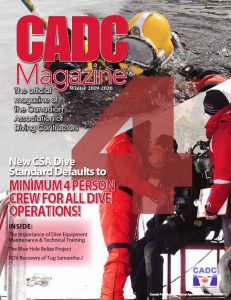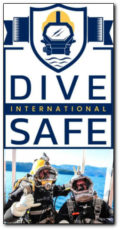CADC MAGAZINE 2019-2020 WINTER AVAILABLE
By CADC Admin ~ January 7th, 2020. Filed under: Latest Diving News.
 With a large number “4” on the cover of this issue of CADC Magazine, we make an in-your-face (read: in-your faceplate) point that if you are on a dive site in Canada and are concerned about safety, simply count the number of competent dive crew on the operation. If it isn’t four or more, ask the dive supervisor how the determination of crew size came about and if it mitigates the risk to the diver and the dive operation. Why does this crew size deviate from what is recognized as “best practice” by responsible diver operators in our industry?
With a large number “4” on the cover of this issue of CADC Magazine, we make an in-your-face (read: in-your faceplate) point that if you are on a dive site in Canada and are concerned about safety, simply count the number of competent dive crew on the operation. If it isn’t four or more, ask the dive supervisor how the determination of crew size came about and if it mitigates the risk to the diver and the dive operation. Why does this crew size deviate from what is recognized as “best practice” by responsible diver operators in our industry?In a survey conducted last year, nearly 80 per cent of responses from divers, supervisors, regulators, and contractors were in favour of a standardized minimum dive crew consisting of a competent supervisor, diver, standby diver, and a tender.
After nearly 10 years of debate at the CSA Dive Standards Committee on this subject, the new diving standard, Z275.2-20 – Diving Operations now defaults to a four-person minimum crew on all diving operations, including SCUBA. We now have a standard that recognizes the importance of an adequate number of trained and competent crew members on the dive site.
With the new release of Z275.2-20 – Diving Operations in effect as of January 2020, the CSA emphasizes the default use of a minimum four-person crew to be required on all occupational diving operations, with only rare exceptions possibly allowed under a completed on-site risk assessment, and a thorough job hazard analysis will determine the correct crew size to mitigate risk.
However, a standard is a standard—not a regulation. The standard (especially the CSA standards) can influence how the dive safety regulations nationally and provincially are formed. It is now up to the provincial industry members to push for change based on those standards. We, at the Canadian Association of Diving Contractors (CADC), have done our part as a national organization by working diligently at the CSA Diving Standards to get this important standard to the table, and to get it passed. It is a powerful tool for provincial diving industry stakeholders to use as leverage to implement change and harmony in diving standards and regulations across the country. See more about the implications of the new changes in the standards on the default four-person minimum crew in the article on page 16.
Divers have lots of stories that usually end with a comment like, “That was nothing! You should have heard of the time we…,” and it goes deep into the night. We asked members of the CADC if they had any stories, and we were deluged with tales. Dive into Chilling Tales Working the Big Freeze: Part II on page 19 to peruse the stories they shared. Some are pretty hard to believe!
For those who embrace winter diving or don’t encounter the “off-season,” there are many considerations and safety checks to ensure you and your team are prepared for cold weather diving. First, make sure you’re not in danger of freezing. Now, that’s using your noggin. And speaking of noggin, that’s what we focus on in Prepping for Cold Weather Diving on page 25. This article by Jonathan Chapple discusses helmet maintenance, what to consider when prepping for gear cold weather diving, and proper helmet use to make sure you don’t freeze up while getting the job done.
On page 27, we dissect the Great Blue Hole Belize (BHB) Expedition, the brainchild of Harvey Flemming, founder of Aquatica. Flemming realized that documenting the Blue Hole would provide priceless advertising and exposure for Aquatica’s 500-foot-depth-rated Stingray submersible. The challenge, however, was getting permission and permits required from the Belizean government to put a submersible into the Great Blue Hole—something that hadn’t been done since Jacques Cousteau documented this cenote in 1971. Mark Atherton, our sonar imaging guru, briefs us on the challenges and results of this exciting project.
A first of its kind, Marc-André Désy discusses a joint tunneling project between Expertech Marine and ASI Group in Quebec. The project will aim to Désy highlights the REM Project happening at the Trudeau Airport Tunnel and explains how the challenges associated with carrying out this ground-breaking operation safely, from digging, to excavating, to building waterproof rings, require hyperbaric intervention support. Flip to page 31 to read more.
On page 33, the CADC member project spotlight shines on Global Diving & Salvage’s ROV recovery of the 35-foot, steel-hull tug Samantha J, which sank in the Northumberland Channel near Nanaimo, BC in 2014 after she was overcome by the barge she was towing. The vessel sank in 230 feet of water and remained submerged for four years, with hundreds of gallons of fuel oil, engine oil, and hydraulic oil on board. Because of the pollution risk and her position on the site of a working ship anchorage, the Canadian Coast Guard ordered its removal. The vessel’s owner also wanted her salvaged; the tug’s hull is unique, and it would be a substantial cost to recertify a new vessel for the work she performs.
Turn to page 37 to see CADC members in action at various dive sites across the country. If you have on-the-job shots you want to share in a future issue, send them (along with a one-line caption) to delsey@ cadc.ca for consideration.
We round out this edition with an update from Dave Geddes, CADC president, and Doug Elsey, CADC executive director, on CADC’s diving safety self-audit worksheet. Flip to page 39 to read more.
This issue will be distributed at the Association of Diving Contractors International’s Underwater Intervention in New Orleans, Louisiana and the Canadian Underwater Show in St. John’s, Newfoundland. In Canada, we move into the dead of winter—and it’s cold! With the new diving standards in effect by the time this issue hits the streets, we look forward to a safer working environment. Right now, it seems like the only environmental thing we can change.
Four—remember the number four! Have a safe and prosperous new year at the start of this new decade; let’s get all of our divers home to the surface safely.
Download the Digital Version of the magazine below:







